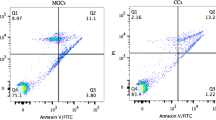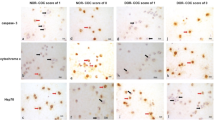Abstract
Purpose: The aim was to establish the impact of human granulosa cell apoptosis and reactive oxygen species (ROS) production on fertilization competence of the oocyte, embryo developmental stage and implantation rate.
Methods: Thirty women undergoing IVF-ET for tubal factor infertility were included; GnRH antagonists and gonadotrophins were used for ovarian stimulation. Granulosa cells were isolated from each aspirated follicle using gradient centrifugation. Apoptosis was studied by flow cytometry using annexin V and propidium iodide. ROS production was studied with hydroethidine staining and analyzed by flow cytometry.
Results: There were no differences in characteristics of granulosa cells between the follicles with fertilized and non-fertilized oocytes. The analyzed characteristics of granulosa cells in corresponding follicles had no effect on embryo developmental stage on day 5. The percentage of ROS producing granulosa cells was lower in the follicles giving rise to blastocysts that resulted in implantation compared to those that did not (39.9% versus 69.9%, P = 0.031).
Conclusions: Apoptosis and ROS production in granulosa cells have no significant impact on fertilization and do not correlate with the development of blastocysts. An increased percentage of ROS producing granulosa cells results in fewer oocytes retrieved and diminishes implantation rate.
Similar content being viewed by others
References
Tilly JL: Apoptosis and ovarian function. Rev Reprod 1996;1:162–72
Tilly JL, Kowalski KI, Johnson AL, Hsueh AJ: Involvement of apoptosis in ovarian follicular atresia and postovulatory regression. Endocrinology 1991;192:2799–801
Nakahara K, Saito H, Saito T, Ito M, Ohta N, Takahashi T, Hiroi M. The incidence of apoptotic bodies in membrana granulosa can predict prognosis of ova from patients participating in in vitro fertilization programs. Fertil Steril 1997;68:312–7
Oosterhuis GJ, Michgelsen HW, Lambalk CB, Schoemaker J, Vermes I: Apoptotic cell death in human granulosa-lutein cells: a possible indicator of in vitro fertilization outcome. Fertil Steril 1998;70:747–9
Kaneko T, Saito H, Takahashi T, Ohta N, Saito T, Hiroi M: Effects of controlled ovarian hyperstimulation on oocyte quality in terms of the incidence of apoptotic granulose cells. J Assist Reprod Genet 2000;17:580–5
Jozwik M, Wolczynski S, Jozwik M, Szamatowicz M: Oxidative stress markers in preovulatory follicular fluid in humans. Mol Hum Reprod 1999;5:409–13
Agarwal A, Saleh RA, Badaiwy MA: Role of reactive oxygen species in the pathophysiology of human reproduction. Fertil Steril 2003;79:829–43
Agarwal A, Allamaneni SSR: Role of free radicals in female reproductive diseases and assisted reproduction. Reprod Biomed Online 2004;9:338–47
Pasqualotto EB, Agarwal A, Sharma RK, Izzo VM, Pinotti JA, Joshi NJ, Rose BI: Effect of oxidative stress in follicular fluid on the outcome of assisted reproductive procedures. Fertil Steril 2004;81:973–6
Sharma RK, Agarwal A: Role of reactive oxygen species in gynecologic diseases. Reprod Med Biol 2004;3:177–99
Agarwal A, Gupta S, Sharma R. Oxidative stress and its implications in female infertility – a clinician’s perspective. Reprod Biomed Online 2005;11:641–50
Attaran M, Pasqualotto E, Falcone T, Goldberg JM, Miller KF, Agarwal A, Sharma RK: The effect of follicular fluid reactive oxygen species on the outcome of in vitro fertilization. Int J Fertil Womens Med 2000;45:314–20
Tarin JJ: Potential effects of age-associated oxidative stress on mammalian oocytes/embryos. Mol Hum Reprod 1996;2:717–24
Seino T, Saito H, Kaneko T, Takahashi T, Kawachiya S, Kurachi H: Eight-hydroxy-2′-deoxyguanosine in granulosa cells is correlated with the quality of oocytes and embryos in an in vitro fertilization-embryo transfer program. Fertil Steril 2002;77:1184–90
Vrtačnik Bokal E, Meden Vrtovec H, Virant Klun I, Verdenik I: Prolonged HCG action affects angiogenic substances and improves follicular maturation, oocyte quality and fertilization competence in patients with polycystic ovarian syndrome. Hum Reprod 2005;20:1562–8
Rothe G, Valet G: Flow cytometric analysis of respiratory burst activity in phagocytes with hydroethidine and 2′,7′-dichlorofluorescin. J Leukoc Biol 1990;47:440–8
Billig H, Furuta I, Hsueh AJW: Estrogens inhibit and androgens enhance ovarian granulosa cell apoptosis. Endocrinology 1993;133:2204–12
Papadopoulos V, Dharmarajan AM, Li H, Culty M, Lemay M, Sridaran R: Mitochondrial peripheral-type benzodiazepine receptor expression. Correlation with gonadotropin-releasing hormone (GnRH) agonist-induced apoptosis in the corpus luteum. Biochem Pharmacol 1999;58:1389–93
Matsubara H, Ikuta K, Ozaki Y, Suzuki Y, Suzuki N, Sato T, Suzumori K: Gonadotropins and cytokines affect luteal function through control of apoptosis in human luteinized granulosa cells. J Clin Endocrinol Metab 2000;85:1620–6
Clavero A, Castilla JA, Nunez AI, Garcia-Pena M, Maldonado V, Fontes J, Mendoza N, Martinez L: Apoptosis in human granulosa cells after induction of ovulation in women participating in an intracytoplasmic sperm injection program. Eur J Obstet Gynecol Reprod Biol 2003;110:181–5
Giampietro F, Sancilio S, Tiboni GM, Rana RA, Di Pietro R: Levels of apoptosis in human granulosa cells seem to be comparable after therapy with a gonadotropin-releasing hormone agonist or antagonist. Fertil Steril 2006;85:412–9
Saito H, Seino T, Kaneko T, Nakahara K, Toya M, Kurachi H: Endometriosis and oocyte quality. Gynecol Obstet Invest 2002;53: 46–51
Lee KS, Joo BS, Na YJ, Yoon MS, Choi OH, Kim WW: Cumulus cell apoptosis as an indicator to predict the quality of oocytes and the outcome of IVF-ET. J Assist Reprod Genet 2001;18:490–8
Host E, Gabrielsen A, Lindenberg S, Smidt-Jensen S: Apoptosis in human cumulus cells in relation to zona pellucida thickness variation, maturation stage, and cleavage of the corresponding oocyte after intracytoplasmic sperm injection. Fertil Steril 2002;77: 511–5
Corn CM, Hauser-Kronberger C, Moser M, Tews G, Ebner T: Predictive value of cumulus cell apoptosis with regard to blastocyst development of corresponding gametes. Fertil Steril 2005;84:627–33
Williams GT, Smith CA: Molecular regulation of apoptosis: genetic controls on cell death. Cell 1993;74:777–9
Shoukir Y, Chardonnens D, Campana A, Sakkas D: Blastocyst development from supernumerary embryos after intracytoplasmic sperm injection: a paternal influence? Hum Reprod 1998;13: 1632–7
Miller JE, Smith TT: The effect of intracytoplasmic sperm injection and semen parameters on blastocyst development in vitro. Hum Reprod 2001;16:918–24
Hsu SY, Hsueh AJ: Tissue-specific Bcl-2 protein partners in apoptosis: An ovarian paradigm. Physiol Rev 2000;80:593– 614
Wiener-Megnazi Z, Vardi L, Lissak A, Shnizer S, Reznick AZ, Ishai D, Lahav-Baratz S, Shiloh H, Koifman M, Dirnfeld M: Oxidative stress indices in follicular fluid as measured by the thermochemiluminescence assay correlate with outcome parameters in in vitro fertilization. Fertil Steril 2004;82:1171–6
Acknowledgements
The authors wish to thank all members of our IVF team for assistance in the study, and Mojca Pirc, B.A., for editing the text.
Author information
Authors and Affiliations
Corresponding author
Rights and permissions
About this article
Cite this article
Jančar, N., Kopitar, A.N., Ihan, A. et al. Effect of apoptosis and reactive oxygen species production in human granulosa cells on oocyte fertilization and blastocyst development. J Assist Reprod Genet 24, 91–97 (2007). https://doi.org/10.1007/s10815-006-9103-8
Received:
Accepted:
Published:
Issue Date:
DOI: https://doi.org/10.1007/s10815-006-9103-8




